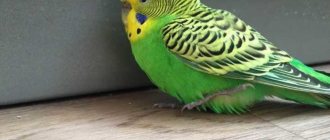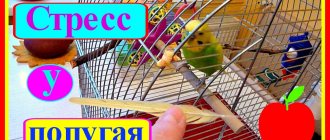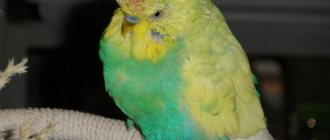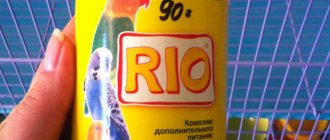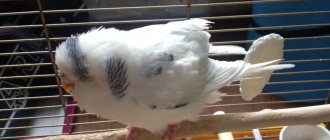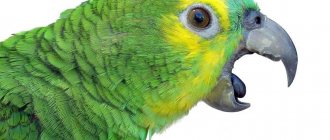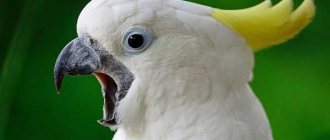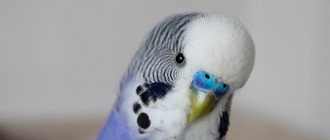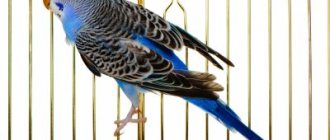An attentive breeder notes all changes in the mood of the ward. It’s just not always clear why the parrot trembles and clucks. How do you know if this behavior is normal or a cause for concern? Bird fever sometimes goes away on its own, but more often it manifests itself as a symptom of the disease. Let's look at the main causes of trembling, first aid and prevention methods.
Stress
Parrots have a highly developed nervous system and they react very vividly to any changes in the environment. The behavior of a newly purchased pet placed in an unfamiliar environment will indicate how easily it adapts to change. If your parrot's tail is shaking or its wing is trembling, it may take some effort to get it comfortable in its new habitat.
It may take about two weeks for your parrot to adapt. During this period, try not to annoy your pet; too intrusive attention can stress him out.
Some useful tips:
- Place the cage at eye level. If you look at your parrot from above, it will feel depressed.
- The cage must always have fresh water and high-quality fortified food.
- Do not allow children to make noise and scream near the cage or pester the parrot.
- Keep other pets away from the cage as they may frighten the bird.
- Accustom your pet to you gradually. Cover yourself with a blanket along with the cage, try to take the parrot in your hands and talk to him affectionately.
If the bird's condition does not improve after 2 weeks, try to identify possible other reasons why the parrot is trembling.
How to prevent your feathered pet's condition from getting worse
For a long and healthy life of a parrot, it is important to comply with all the conditions of its maintenance. It is important to carefully monitor his behavior and the slightest deviations from the norm. If a parrot raises its feathers, puffs itself up, has its eyes closed, and hides its head under its wing, this is hypothermia.
Temperature is an important factor for the health of a pet parrot. Variegated birds naturally live in hot countries. Warmth is their natural habitat. But they also do not tolerate heat well. The optimal comfortable temperature should range from +22…+25 C°. It is allowed to drop to +18 Cᵒ, but no more than an hour. This temperature is not comfortable for heat-loving birds and can cause the development of colds.
Higher temperatures and dry air provoke the appearance of skin diseases. This may be itching, loss of feathers, dry mucous membranes. As a result, the parrot begins to lose appetite and may get sick.
Chills and ruffled feathers are not symptoms of serious illness. Heating and a calm environment in the house will quickly relieve your pet from discomfort. If all the conditions are met, and the bird only gets worse, it is important not to ignore other symptoms. If the disease is detected at an early stage, it responds well to treatment.
First flights
If a young parrot's wings are trembling, it may soon attempt to fly. Your parakeet should be allowed to fly indoors for two hours a day. He must fly under supervision in a safe environment. It is necessary to remove traumatic objects and avoid contact with other pets: rats, dogs, cats.
A lack of calcium can negatively affect a bird's ability to fly. Place mineral stones and sepia, cuttlefish shell in the cage.
Dangerous symptoms that may accompany a parrot with chills
The parrot's trembling, lethargy and closed eyes may indicate not only its hypothermia. If the cause is illness, then other symptoms will appear within 3 days. It is important to identify them as early as possible.
Clear signs of dangerous diseases:
- a bent leg tucked under the body or a drooping wing indicates dislocations and fractures;
- small purulent or bleeding wounds on the body - may indicate various skin diseases;
- digestive disorders: diarrhea, constipation, vomiting;
- lack of appetite, sleepiness, immobility indicate colds or poisoning;
- baldness with itching and redness of the skin indicates the presence of parasites in the bird;
- trembling with convulsions, loss of appetite, hoarseness, uncharacteristic sounds that the pet makes - this is a cold or goiter.
On a note! If the parrot is crested and trembling, or other dangerous symptoms appear, it is necessary to conduct an examination at a veterinary clinic.
Disease
The sight of a ruffled, trembling parrot may indicate the development of a serious illness. The following accompanying signs should alert you:
- Changes in the color, smell and consistency of droppings;
- lack of appetite;
- dyspnea;
- apathy;
- excessive loss of feathers.
Parrots kept at home can suffer from infectious diseases. They are susceptible to gastrointestinal diseases, bronchitis is common; what to do if the parrot is trembling and dangerous symptoms are detected? It is necessary to urgently consult a specialist for advice.
If for some reason this cannot be done, follow the recommendations that will help alleviate your pet’s condition.
- Keep your parrot warm. Cover half of the cage with a towel, and above the other half place a lamp with an incandescent lamp of 40 - 60 W at a height of 30 cm. The parrot will bask under the lamp, and if it gets hot, it will move to the covered part of the cage. The lamp is turned on for 20–30 minutes during the day every 3 hours. Important! Do not use a fluorescent lamp; its flickering will irritate and unnerve the bird.
- If there are signs of poisoning (loose stools, vomiting), be sure to give your parrot a sorbent, enterosgel or activated carbon. It is diluted with water and injected using a syringe without a needle into the slit near the beak, 3 to 4 drops several times a day. Pour chamomile infusion diluted with water (1:1) into the drinking bowl and change it often during the day; Fill the drinking bowl with clean water at night.
Don't ignore your trembling parrot. If you don't take action in time, you may lose your pet.
Why is he shaking his head?
Your pet may shake their head for many reasons:
- Looking for someone.
- Be sick.
- Particles of grains remained in the crop.
- Presence of a tracheal mite.
To exclude these diseases, it is necessary to conduct a visual inspection for damage and palpate the bird’s body: wings, legs, torso. A healthy individual shakes its head for reasons of anxiety, fear or curiosity. The inflammatory process may be accompanied by nausea and diarrhea.
The grains are stuck in the crop
Cockatiels and budgies should not be fed large, unmilled grains. If swallowed, the bird may not completely separate them, which will cause pain in the crop. The stuck piece can be felt with light movements. Ignoring the symptom leads to the death of the pet. Trembling in the body is sometimes accompanied by food coming out of the beak, which can occur in case of overeating.
Presence of a tracheal mite
The tracheal mite is a parasite that lives in the upper respiratory tract of birds and feeds on the contents of the secretion, affecting the respiratory system: trachea, larynx. As the mite grows, it limits access to oxygen. When trying to breathe, the cockatiel begins to shake its head from side to side.
It is necessary to take a smear for parasites and analyze the droppings. After receiving the result, the doctor prescribes antiparasitic drugs if necessary. The treatment process lasts 2 weeks. The first symptoms of the onset of the disease are wheezing, coughing and slight loss of voice. The symptom of trembling can also cause other parasitic diseases that appear against the background of vitamin deficiency.
If your pet continues to tremble for 24 hours, you should take your cockatiel to the veterinarian.
Nausea
Nausea and tremors in birds appear due to poor nutrition, failure to observe meal times, the presence of difficult-to-digest food components, scarcity of vitamins in the feed, and monotony of the diet. If the symptom is not cured in time, then gradually the movements become slow, the bird is passive, apathetic to everything, the pet often shakes its head, trying to get rid of the unpleasant symptom on its own.
Nausea can be the cause of poisoning, symptoms of parasitic diseases, skull trauma, and pathological processes of the digestive system. In such cases, the cockatiel needs care and a special treatment method.
Tumor of the swallowing organs
The tumor is a rare disease of birds, which during the growth process blocks access to air. During life, malignant cancer releases toxic substances into the blood, and during decay, toxic compounds that cause inflammatory processes, increased body temperature, which results in chills. Small tumor-like growths interfere with the development of vocal melody, and the individual begins to shake its head.
The process manifests itself in the form of symptoms: body trembling, difficulty swallowing, tickling.
A tumor of the respiratory organs is caused by inflammatory processes. In this case, it is necessary to apply dry heat to the sore spot and give the bird only warm water to drink. If the procedures are performed frequently, the swelling will be relieved quickly. Impaired swallowing is a dangerous symptom; if it is not eliminated, the pet will die from suffocation.
Injury
If the parrot has suffered a spinal injury, where the nervous system is involved, the initial symptoms will appear in the form of head twitching. If the parrot experiences pain, then it is necessary to find out where the damage occurred.
Avitaminosis
The parrot is shaking due to a lack of vitamins. You should consult your veterinarian about this. Perhaps changing the food to one enriched with microelements will help. After consultation, a vitamin supplement is chosen for the main diet. Feeding with fresh vegetables and fruits cannot be ignored. Almost everything suits parrots except papaya, persimmons and nuts. It is also necessary to offer the bird greens:
- sorrel;
- dandelions;
- wheatgrass;
- shepherd's bag
The main thing is to find out in time why the parrot begins to shake.
Read also: How to find it in Google's cache?
Poisoning
The causes of poisoning can be various factors:
- Poor quality food and water with possible bacterial and fungal infections;
- Foods prohibited for consumption by parrots;
- Accidental consumption of poisonous indoor plants by a bird;
- Chemical poisoning: aerosol substances used by humans in enclosed spaces;
- Intoxication resulting from direct contact with low-quality feeders, drinkers and toys made using toxic materials;
If the parrot gets ruffled and vomits, this is obvious poisoning.
Symptoms of poisoning include vomiting, seizures, and changes in the concentration and color of droppings. With severe intoxication, loss of coordination may occur. In some cases, trembling and paralysis. It is very important to notice this problem at an early stage and begin treatment immediately.
Treatment
If it is not possible to seek the help of a veterinarian, then you can do the following. In case of poisoning by toxic fumes, first of all you need to ventilate the room where the parrot is located. In other cases, liquid drugs with adsorbing action are used. They are introduced into the bird's mouth in a few drops through a pipette or syringe.
Dry preparations, such as activated carbon, are dissolved in clean water until they become semi-liquid. Then 1-2 drops are injected through a medical syringe into the side of the beak. A decoction of flaxseed can be used as a laxative. In case of diarrhea due to dehydration, the patient should be constantly given a few drops of clean water. You can feed liquid baby porridge without milk, often and little by little.
A cold causing swelling of the larynx
A parrot's cold leads to swelling of the throat mucosa. He cannot swallow the grain, so he begins to actively nod his head, helping himself to push the food through. With this disease, a cough appears and the parrot spits out food. He begins to feel chills, the bird often sits motionless, ruffled.
Warmth becomes the cure. It is necessary to install a lamp near the cage and direct the light at the pet. The lamp power should not exceed 60 W. During heating, temperature control is necessary to prevent overheating.
Add warm water with a drop of lemon juice or honey to the drinking bowl. You can place a container with hot liquid next to the cage, into which a few drops of eucalyptus oil are added. This is how birds are inhaled.
In especially severe cases, the use of potent drugs is necessary. Only a veterinarian can prescribe antibiotic therapy.
Tags
Why does a parrot tremble? Parrot owners should tremble. Parrots often tremble. Budgerigar owners should. A budgerigar can. A budgerigar and budgerigars are susceptible. A sick budgerigar shakes. A budgerigar can shake. budgerigar will help budgerigar faster
shiverhypothermiawavymovementownersprocesseschange
Crop blockage
One of the reasons for head nodding is a blockage of the goiter. Parrots that have not received a balanced mineral diet for a long time develop the habit of filling their crop sac to the limit. There, grains and other dry foods mix with saliva and swell. The proper functioning of the goiter muscles is disrupted. Because of this, the parrot begins to yawn and stretch upward to push food through. At the same time, he actively shakes his wings. In mild cases, you can give a simple decoction of medicinal chamomile. If this does not help, you need to contact your veterinarian.
Treatment consists of rinsing the goiter with clean water in a small volume. The stuck food is carefully pulled out through the throat or pumped out through a special tube. The crop should be washed until it is completely free of the clogged substance. In case of complications, surgical intervention is necessary. In this case, an incision is made in the wall of the goiter and its contents are removed. Then the throat is treated with a disinfectant solution and sutured. During the recovery period, the bird is fed only liquid food.
https://youtu.be/BbfMWFumygI
Some diseases of the nervous system can lead to uncontrolled eating of food. Its excess can also lead to blockage of the goiter. In this case, the parrot becomes indifferent to what is happening around. A sick pet begins to behave unusually, nodding periodically. It becomes inactive, and an unpleasant odor appears from the beak. A mucous mass is released from the mouth, the plumage of the head completely sticks together. In case of periodic inflammation of the goiter, the feathered pet must be shown to a specialist.
Adaptation of a bird to a new home
When changing a cage or moving to a new home, a parrot may feel not just discomfort, but even severe stress. You will notice that he is cackling and shaking, but you will not understand why. If you have recently moved or bought a new cage, then you will just need to wait until the bird gets used to it, carefully examining its home with its eyes.
Sorry, there are no surveys available at this time.
Talk to him, monitor his behavior and do not let him out for several days. Let the baby get used to the new home, look around, notice all the toys. It happens that the bird gets ruffled and looks irritated and constantly angrily rushes at some object. To calm your pet, simply remove the irritant from the cage.
Colds
The homeland of parrots, in most cases, is hot countries (Africa, Australia, South America). Any, even seemingly short-term, ventilation of the room can cause colds in birds. The temperature regime must always be observed, depending on the type of parrot.
Cold air, drafts, and swimming in cold water are the causes of the disease.
Symptoms:
- ruffled appearance;
- lethargy and apathy;
- lack of playful and active mood;
- the appearance of heavy breathing or shortness of breath;
- sneezing;
- mucous discharge from the nostrils;
- sagging of the bird's tail to an almost vertical position.
If the parrot is ruffled and trembling, this is a clear sign of a cold. In this case, the bird may refuse to eat food and water.
Contaminated air
Parrots have a special respiratory system, which includes several air sacs. During flight, these bags control body temperature, prevent overheating, and also enrich all internal systems and organs with oxygen several times better than in mammals.
This breathing system is very sensitive to various impurities in the air. Toxic particles and strong odors can be fatal, so it is necessary to ensure that perfumes, household aerosols, tobacco smoke, and air fresheners are not sprayed near the cage. During renovations in an apartment using varnishes and paints, glue, and other substances with a strong odor, the parrot should be left with relatives or friends. Toxin poisoning is difficult to treat, as it has a detrimental effect on the central nervous system and respiratory organs.
Are there preventive measures?
Despite the fact that parrots are quite unpretentious to their living conditions, they still need comfort and coziness. The homeland of these birds is in countries with hot climatic conditions, for this reason they need the same conditions in captivity. Hypothermia can be fatal for this species of bird; in particular, they can develop kidney disease, which is difficult to treat.
As a preventive measure against the occurrence of any disease, it is to avoid drafts and sudden temperature changes, since they are delicate and sensitive creatures and are so easily susceptible to colds.
They can easily catch an infectious disease from their owners, so if you are sick, do not go near them under any circumstances, most likely they will get infected from you, and it will not be so easy to cure them.
And most importantly, you should not take on the treatment of a parrot on your own, because you will still not be able to provide highly qualified assistance, and you will miss out on valuable time. Due to the fact that the metabolism of parrots is carried out at a high speed, all diseases in them develop extremely quickly. So, don’t be late and save your pet!
Tracheal mite
This avian parasite causes a disease called sternostomosis. This disease affects the internal organs, larynx and trachea. Due to difficulties with swallowing and breathing, the parrot begins to actively shake its head and may even spit out grains. You can understand why a parrot shakes its body if you track other symptoms. At first, there is a partial loss of voice, coughing, and wheezing.
To accurately diagnose the disease, it is necessary to take a tracheal smear to check for parasites. A litter analysis is also needed. If the test shows the presence of mites, the veterinarian will prescribe treatment.
Important! The dosage of medications, the treatment itself and its duration are determined only by a specialist.
The prescribed medications are taken for about 2 weeks.
The parrot is trembling or ruffled: what does this mean?
Do you notice that the bird is shaking and clucking, but you don’t know why? A parrot's body trembling may mean that your pet is sick, scared, or in discomfort. Everything can be simple or very complicated, but this fact certainly cannot be ignored. If you get yourself a parrot, you must take care of it and protect it from various dangers.
Experienced bird owners have probably more than once encountered the problem when the bird trembles, puffs itself, and often closes its eyes. Behavior that is uncharacteristic for a pet is the first warning signal for the owner that urgent action needs to be taken. Sometimes it’s enough just to warm up the bird, and sometimes you need to quickly go to the doctor. First, you should take a close look at the bird to understand why it is ruffled, and only then draw conclusions regarding its condition.
Prevention
To eliminate unpleasant symptoms from your pet’s life, it is necessary to create acceptable feeding and maintenance conditions:
- Include fruits and vegetables in your diet. Feed regularly with food fortified with vitamins. Food and drink must be freely available. Check expiration dates on food regularly. Do not allow moldy products to be consumed.
- Artificially adjust daylight hours, giving the opportunity to fully rest.
- Avoid hypothermia and overheating.
- Do not create conditions for stress.
- Do not leave poisonous indoor plants, medications and small objects in the public domain.
If you follow the rules of care and take proper care, a budgie can live up to 15 years. A truly careful owner can extend its lifespan to 18 years. After all, only careful treatment of your pet keeps it active for a long time.
